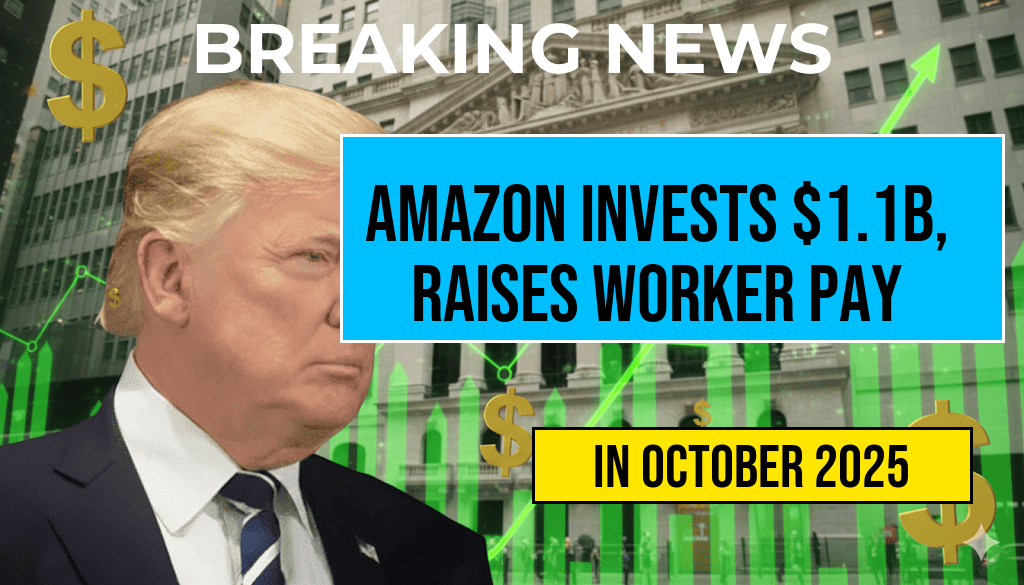Amazon has announced a significant investment of $1.1 billion aimed at enhancing its fulfillment operations and improving conditions for its warehouse workers. As part of this initiative, the company has increased the average pay rate for fulfillment employees to over $23 per hour. This move reflects Amazon’s ongoing efforts to address labor concerns and remain competitive in the increasingly tight U.S. labor market. The company claims that the new investments will not only elevate worker compensation but also bolster operational efficiency and customer service standards across its vast network of fulfillment centers.
Investment Details and Expected Impact
Amazon’s commitment to investing over a billion dollars into its fulfillment infrastructure signals a strategic shift aimed at both worker satisfaction and operational resilience. The company states that the $1.1 billion will be allocated toward wage increases, facility upgrades, and enhanced employee benefits. The immediate effect has been a rise in the average hourly wage for fulfillment staff, surpassing the $23 mark—a notable benchmark for logistics and warehousing roles in the sector.
According to Amazon, this wage boost is part of its broader plan to attract and retain talent amid a competitive labor environment. The company has faced criticism in recent years over working conditions, prompting efforts to improve employee experience and compensation. Industry analysts see this as a move to mitigate turnover rates and foster a more motivated workforce, which is critical given the company’s rapid expansion and delivery demands.
Worker Compensation and Benefits
| Component | Details |
|---|---|
| Average Hourly Wage | > $23 per hour |
| Additional Benefits | Health insurance, 401(k) plans, paid time off, and career development programs |
| Wage Increase Effective Date | Immediately following the announcement |
| Projected Annual Cost | Approximately $1.1 billion |
Employees working in Amazon’s fulfillment centers will see a noticeable increase in their paychecks, with many earning above the previous average of around $18–$20 per hour. The company emphasizes that alongside higher wages, workers will have access to comprehensive benefits, including health care coverage, retirement savings plans, and opportunities for advancement within the organization.
Market and Industry Response
Labor Market Dynamics
Amazon’s wage hikes come amid a broader trend of companies competing for labor in a tight job market. The U.S. Bureau of Labor Statistics reports that warehouse and logistics employment has surged in recent years, driven by e-commerce growth and supply chain demands. As a result, firms like Amazon are investing heavily to attract skilled workers and reduce turnover.
Competitive Positioning
While Amazon’s increases are among the highest in the logistics sector, several competitors have also raised wages to secure staffing levels. For instance, warehouses operated by retailers such as Walmart and Target have similarly boosted pay and benefits, aiming to improve worker satisfaction and operational stability.
Broader Implications for the E-Commerce Sector
Amazon’s substantial financial commitment underscores the importance of labor investments in maintaining e-commerce dominance. Higher wages can lead to improved employee morale and productivity, which are crucial for meeting rising consumer expectations for fast delivery and reliable service. However, critics argue that such investments may also lead to increased operational costs, potentially influencing product pricing and profit margins.
Impact on Consumer Expectations and Delivery Times
Enhanced worker compensation often translates into better service quality, but it also requires companies to balance labor costs with operational efficiency. Amazon’s investments aim to uphold its pledge of rapid delivery times, even amid rising labor expenses.
Looking Ahead
Amazon’s latest financial move signals a recognition that investing in its workforce is integral to sustaining growth and competitiveness. As labor costs rise, the company’s ability to innovate and streamline operations will be critical. Meanwhile, industry observers will watch closely to see whether similar wage increases ripple through the logistics and retail sectors, potentially reshaping employment standards in the e-commerce landscape.
For further insights into Amazon’s operational strategies and industry trends, visit Wikipedia’s Amazon page or consult reports from Forbes.
Frequently Asked Questions
What is the total investment Amazon has made to improve worker wages?
Amazon has invested 1.1 billion dollars to boost the pay of its fulfillment workers.
How has Amazon’s investment impacted fulfillment workers’ average hourly pay?
The investment has increased the average pay for fulfillment workers to over twenty-three dollars an hour.
Why did Amazon decide to increase fulfillment workers’ wages?
Amazon increased wages to attract and retain skilled workers, improve working conditions, and stay competitive in the labor market.
Does the wage increase apply to all Amazon fulfillment centers?
Yes, the wage increase applies broadly across Amazon’s fulfillment centers to benefit a large portion of its logistics workforce.
How might this wage boost affect Amazon’s overall business operations?
The wage increase may lead to improved employee satisfaction, reduced turnover, and enhanced operational efficiency, positively impacting Amazon’s business.






